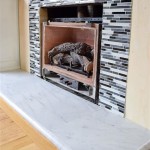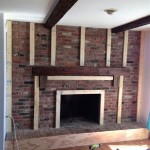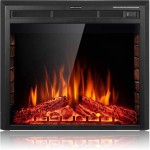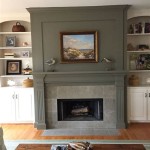Veneer Stone For Fireplace Surround: A Comprehensive Guide
A fireplace serves as a focal point in many homes, providing warmth and ambiance. Enhancing its aesthetic appeal is often a primary consideration for homeowners. Veneer stone offers an attractive and versatile option for updating or creating a visually stunning fireplace surround. This article explores the various aspects of using veneer stone for fireplace surrounds, covering styles, installation, and maintenance.
Veneer stone is a manufactured product designed to replicate the look and feel of natural stone. It is typically thinner and lighter than natural stone, making it easier to install and suitable for a wider range of applications. The material is composed of a concrete mixture that is molded and colored to mimic different types of natural stone, such as limestone, fieldstone, river rock, and stacked stone. This allows for a wide variety of aesthetic choices to complement any interior design scheme.
One of the major advantages of using veneer stone is its cost-effectiveness. While natural stone can be expensive to acquire and install, veneer stone offers a more budget-friendly alternative without sacrificing visual appeal. Its lightweight nature also reduces shipping costs and simplifies the installation process, further contributing to overall cost savings.
Styles and Design Considerations
The selection of veneer stone for a fireplace surround depends on the desired aesthetic and the existing style of the room. Numerous styles are available, each offering a distinct look. Stacked stone veneer, for example, provides a contemporary and linear appearance, often used in modern or minimalist designs. Fieldstone veneer, on the other hand, imitates the look of naturally gathered stones, creating a rustic and traditional feel. River rock veneer evokes a sense of natural serenity with its smooth, rounded shapes. Limestone veneer offers a classic and elegant appearance, often used in more formal settings.
Color is also a crucial consideration when selecting veneer stone. Neutral colors like gray, beige, and brown are versatile and can blend seamlessly with various color palettes. For a more dramatic effect, darker shades like charcoal gray or even black can create a bold statement. Ultimately, the color choice should complement the existing décor and create a cohesive design.
Beyond the style and color of the veneer stone, the layout and arrangement of the stones are essential. Some homeowners prefer a random pattern to mimic natural stone formations, while others opt for a more structured and uniform layout. The size and shape of the individual stone pieces can also vary, influencing the overall appearance. Consider the size of the fireplace surround when determining the size and arrangement of the veneer stone. Smaller stones may be more suitable for smaller fireplaces, while larger stones can create a more impactful statement on larger surfaces.
The texture of the veneer stone also contributes significantly to the overall aesthetic. Rough-textured stone provides a more rustic and rugged appearance, while smoother stone offers a more refined and contemporary look. The selection of texture should align with the desired style and complement the other materials in the room, such as wood, metal, and glass.
Installation Process
The installation of veneer stone on a fireplace surround, while generally straightforward, requires careful planning and execution. The process typically involves preparing the surface, applying mortar, and setting the stones. A thorough understanding of these steps is crucial for a successful installation.
Surface preparation is paramount. The surface on which the veneer stone will be applied must be clean, structurally sound, and free of loose debris. If the existing surface is painted or coated, it may need to be roughened to provide a better bond for the mortar. A scratch coat of mortar may be required to create a suitable surface for the veneer stone.
Mortar is used to adhere the veneer stone to the surface. It is important to use a mortar specifically designed for veneer stone installation, as these mortars are formulated to provide superior adhesion and flexibility. The mortar should be mixed according to the manufacturer's instructions, ensuring the correct consistency. The mortar is typically applied to the back of each stone and then pressed firmly onto the prepared surface. Spacing between the stones can be adjusted to create different effects, such as a tight fit or a more rustic, open-jointed appearance.
Cutting veneer stone may be necessary to fit the stones around the fireplace opening or to create a desired pattern. A wet saw with a diamond blade is generally recommended for cutting veneer stone, as it provides a clean and precise cut while minimizing dust. Safety precautions, such as wearing eye protection, should be taken when cutting veneer stone.
After the veneer stone has been installed, excess mortar should be removed from the surface using a grout sponge and water. The mortar joints can be tooled or finished to create a desired look. This process involves using a jointing tool to shape and compact the mortar in the joints.
Maintenance and Durability
Veneer stone is generally a durable and low-maintenance material, making it a practical choice for fireplace surrounds. However, proper care can extend its lifespan and preserve its aesthetic appeal. Regular cleaning is essential to remove dust, dirt, and soot that may accumulate on the surface.
Cleaning veneer stone typically involves using a soft brush or cloth and a mild detergent. Avoid using harsh chemicals or abrasive cleaners, as these can damage the surface of the stone. Pressure washing is generally not recommended, as it can potentially damage the mortar joints and the stone itself.
Sealing veneer stone is an option that can provide added protection against staining and water damage. A sealant designed specifically for veneer stone should be used, following the manufacturer's instructions. Sealing may be particularly beneficial in areas prone to moisture or staining, such as around the fireplace opening. The frequency of resealing will depend on the type of sealant used and the level of exposure to the elements.
While veneer stone is durable, it is not impervious to damage. Impacts from sharp objects can chip or crack the stone. In the event of damage, individual stones can typically be repaired or replaced. Minor chips or cracks can be filled with a color-matched patching compound. Severely damaged stones may need to be removed and replaced with new ones.

Natural Stacked Stone Veneer Fireplace Ideas

11 Stone Veneer Fireplace Surround Design Trends Where To Buy

Can I Install Stone Veneer Around My Gas Fireplace Stoneyard

The Benefits Of Thin Stone Veneer For Your Fireplace

Fireplaces Eldorado Stone

11 Stone Veneer Fireplace Surround Design Trends Where To Buy

Stone Fireplace Surround Ideas You Ll Love Columbia Mo

Thin Stone Veneers Make A Fireplace Update Easy

Stone Veneer Fireplace Ideas That Will Warm Up Your Home Ply Gem

Natural Stacked Stone Veneer Fireplace Ideas
Related Posts








